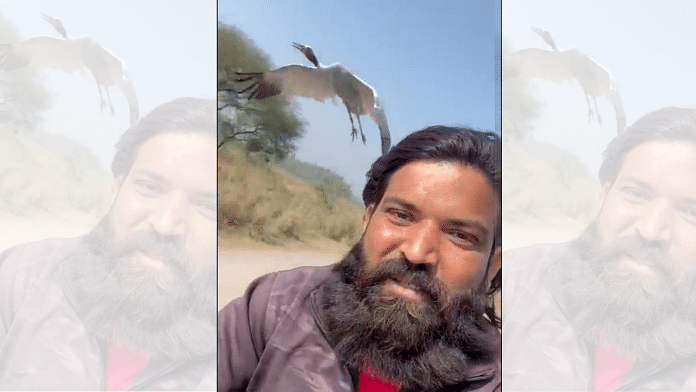New Delhi: It is not often that Mandhka Majre Aurangabad, a village nestled in the Gauriganj tehsil of Uttar Pradesh’s Amethi finds itself in the news. But, Muhammad Arif has changed things –– thanks to his relationship with a Sarus crane.
The bird found itself injured in Arif’s village. Its leg was broken. He took care of it, nursing it back to health. One would expect that once it had been fully rehabilitated, it would return to the forest. But, this did not happen and the bird continued to stay with Arif. “I thought it would go back to its friends, to where it came from. But this did not happen,” said Arif in an interview.
The relationship is such that when Arif travels, the bird follows. In a video, Arif can be seen zooming on his motorbike, while the bird flaps its wings, just a few feet behind –– never drifting too far away from its human companion. “The bird travels up to 30-40 kilometres with me,” he said.
आरिफ उसे अपने घर ले आया. इलाज किया भोजन पानी दिया. पक्षी ठीक होने पर बजाए जंगल की ओर जाने के आरिफ के संग ही रहने लगा. आरिफ कहीं पर बाइक लेकर जाते हैं तो वह उनके ऊपर हवा में उड़ता रहता है, 30–40 किलोमीटर तक ऊपर उड़ान भरकर साथ साथ चला जाता है. अब सारस अपने रक्षक का मुरीद है😊 pic.twitter.com/nvle4Jl1BF
— gyanendra shukla (@gyanu999) February 21, 2023
The bird is attached to the point where if Arif leaves for a few hours, it is waiting, and is excited upon his return –– happily playing with him.
“His friends come on occasion, to take him back. But he never goes. He hides in the verandah. He plays with them sometimes. But in the evening, they return home and he comes back to me,” said Arif.
This playful, loving relationship is unique to Arif. His family members are afraid of the red-necked, long legged, sharp-beaked and all around rather large creature.
In another video, the bird can be seen eating pieces of roti straight from Arif’s hand. It looks most at ease, as does Arif. When standing, it comes almost till his shoulders.
A vulnerable species
The Sarus crane is the world’s tallest flying bird, according to the World Wildlife Fund, with an estimated global population between 25,000 and 37,000.
Listed as a vulnerable species, in India there are between 15,000 and 20,000. Their primary threat lies in human encroachment, as more of their habitat becomes agricultural land and the wetlands are drained.
Courtesy the increase in agricultural land, they are left with no choice but to forage in the fields, ingesting pesticides and consequently being poisoned.
In a stroke of good news, the Sarus crane population has almost doubled in the wetlands of Matar Taluka, in Gujarat’s Kheda, due to sustained conservation projects conducted in collaboration with locals and the district forest department, reported The Indian Express.
Also read: ‘Threat to wildlife ignored’ — Maharashtra blackbucks death puts spotlight on roadkill mitigation



